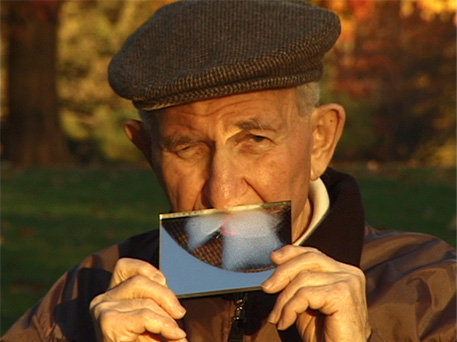Neil Goldberg
dal 17/8/2007 al 11/10/2007
Segnalato da
17/8/2007
Neil Goldberg
The Jewish Museum, New York
Love and loss: a video trilogy

Love and loss: a video trilogy
The Jewish Museum will present Love and Loss: A Video
Trilogy by Neil Goldberg from August 18 to October 12, 2007 in the
Museum's Barbara and E. Robert Goodkind Media Center. Neil Goldberg's
videos are personal yet detached, humorous and poignant reflections on
aging, mourning, and death. He uses family members as willing subjects
and agents in his conceptual art practice.
In My Parents Read Dreams I've Had About Them (1998, 8 min.),
Goldberg's mother and father recite humorous and surreal transcripts
handed to them by the artist. With a sharp sense of wit, Goldberg uses
his lens to broach difficult subjects such as fear of failure, familial
rejection, and aging. In A System for Writing Thank You Notes (2001, 8
min.), the artist's widowed father explains his efficient method for
acknowledging condolence cards and other expressions of sympathy.
The
uncomfortably comical explanation demonstrates how order and dispassion
are necessary tools in the grieving process. My Father Breathing Into a
Mirror (2006, 1 min.) is an existential meditation featuring Goldberg's
father (who passed away in 2007) in the foreground of an autumnal
landscape.
Neil Goldberg's work was included in The Jewish Museum's 1996
exhibition, Too Jewish? Challenging Traditional Identities, and has been
shown in The New York Jewish Film Festival, co-presented by The Jewish
Museum and the Film Society of Lincoln Center. His art has also been on
view at The Aldrich Contemporary Art Museum, Berkeley Art Museum/Pacific
Film Archive, The Hammer Museum The Kitchen, The New Museum of
Contemporary Art, and The Wexner Center for the Arts. Goldberg's videos
have been screened at the British Film Institute, the San Francisco
International Film Festival, and Thirteen/WNET's Reel New York. His
work is in the permanent collections of The Jewish Museum and The Museum
of Modern Art. Neil Goldberg is represented by Sara Meltzer Gallery in
New York.
Located on the third floor of The Jewish Museum, the Goodkind
Media Center houses a digital library of radio and television programs
from the Museum's National Jewish Archive of Broadcasting (NJAB). It
also features a changing exhibition space dedicated to video and new
media. Using computer workstations, visitors are able to search
material by keyword and by categories such as art, comedy, drama, news,
music, kids, Israel, and the Holocaust.
About the National Jewish Archive of Broadcasting
The National Jewish Archive of Broadcasting, founded in 1981 in
association with the Charles H. Revson Foundation, is the largest and
most comprehensive body of broadcast materials on 20th century Jewish
culture in the United States. With a mission to collect, preserve and
exhibit television and radio programs related to the Jewish experience,
the NJAB is an important educational resource for critical examination
of how Jews have been portrayed and portray themselves, and how the mass
media has addressed issues of ethnicity and diversity. Its collection
is comprised of 4,300 broadcast and cable television and radio programs.
About The Jewish Museum
The Jewish Museum was established on January 20, 1904 when Judge Mayer
Sulzberger donated 26 ceremonial art objects to The Jewish Theological
Seminary of America as the core of a museum collection. Today, The
Jewish Museum maintains an important collection of 25,000 objects -
paintings, sculpture, works on paper, photographs, archaeological
artifacts, ceremonial objects, and broadcast media. Widely admired for
its exhibitions and educational programs that inspire people of all
backgrounds, The Jewish Museum is the preeminent United States
institution exploring the intersection of 4,000 years of art and Jewish
culture.
Opening august 18, 2007
The Jewish Museum
1109 Fifth Avenue at 92nd Street - New York



